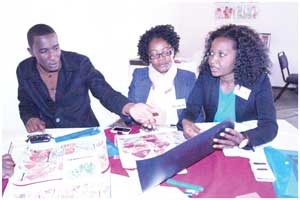
Trained to deal with disaster risk

Staff members of the information ministry at one of the Disaster Risk Management Training sessions that began on Monday and ends on Friday this week in Okahandja. (Photograph by David Adetona)
The training aims to reskill and expand the capability of the ministry’s regional information officers in order to sensitise, educate, inform, remind, encourage or empower the community on how to prepare or respond to crisis situations.
According to Tjiuai Kaambo, director of Print Media Affairs at the ministry, this type of specialised training is also essential to boost the ministry’s initiative of implementing government policy that aims to enhance national capacity in disaster risk management in reducing the risks and increased resilience to the multiple hazards facing the country.
She said that disasters, emergencies, natural and man-made accidents such as flood, drought, deforestation, epidemics, wild or bush fire, sea, air and rail accidents threaten every society and business and can reduce productivity, or interrupt logistics leading to unexpected socio-economic losses.
“In addition, there has been a dramatic rise in the frequency and magnitude of disasters or emergencies in the country that threatened larger population living in diverse environments in recent years. If these trends continue, the cost associated with natural disasters or emergencies will continue to increase and place more people at risk,” she said.
She further said that the increased effect of climate change, industrialisation, exploration of mines, construction of manufacturing plants or other developments in the country makes disaster or emergency preparedness an urgent priority.
The capacity building model for this programme was designed in 2011 following the flood emergency and large scale disaster in the northern regions.
Speaking on behalf of the IOM (International Organisation for Migration) head to Namibia, Newton Muli, IOM DRM trainer, Pedro Salavessa said it is commendable to see how the overnment has driven the process forward for a strong foundation and institutional framework to disaster management.
“Today the country has a Disaster Risk Management Act (Act no. 10 of 2012), corresponding regulations currently being drafted, a National Disaster Risk Management Plan and a Policy which all serve as guiding documents for disaster risk management practitioners in Namibia. The next step for all of us is to implement and operationalise these,” he said.
The information ministry last month reached an agreement with IOM to conduct this training in line with the recommendation made at the Disaster Risk Training workshop held in May this year in Swakopmund.











































